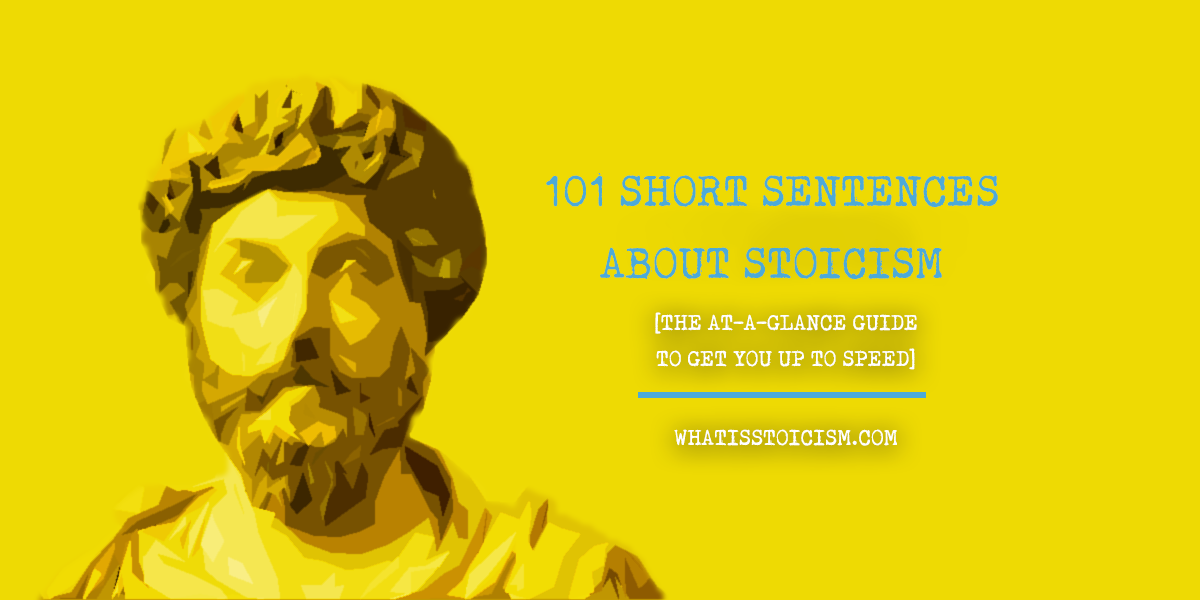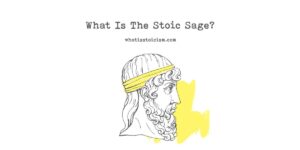If you’re new to Stoicism, or just in need of a refresher, here are 101 short sentences covering the key concepts of the philosophy!
Origins
- Stoicism was founded by Zeno of Citium in Athens around 300 BC.
- The name is derived from the “Stoa Poikile” (“Painted Porch”) where Zeno taught from.
- Stoicism was one of the major schools of philosophy from the Hellenistic period through to the Roman era.
- The history of Stoicism is usually divided into three phases: Early Stoa (3rd century BC), Middle Stoa (1st and 2nd century BC), and Late Stoa (1st and 2nd century AD).
Philosophers
- Stoic philosophers from the Early Stoa phase included Zeno of Citium, Cleanthes, Chrysippus, Diogenes of Babylon, and Antipater of Tarsus.
- Stoic philosophers from the Middle Stoa phase included Cato the Younger, Panaetius and Posidonius.
- Stoic philosophers from the Late Stoa phase included Seneca The Younger, Musonius Rufus, Epictetus, and Marcus Aurelius.
Zeno of Citium
- Zeno was born c. 334 BC in Citium, Cyprus.
- Zeno’s ideas were developed from his studies under philosophers such as Crates, Stilpo, Diodorus Cronus, and Philo.
- Zeno believed that the whole Universe is God, a divine reasoning entity, where all the parts belong to the whole.
- Zeno died c. 262 BC in Athens.
Chrysippus
- Chrysippus was born c. 279 BC in Soli, Cilicia.
- Chrysippus was a pupil of Cleanthes and succeeded his teacher as head of the Stoic school following Cleathes’s death c. 230 BC.
- Chrysippus expanded the fundamental doctrines of Zeno of Citium, the founder of the school, which earned him the title of Second Founder of Stoicism.
- Chrysippus died c. 206 BC in Athens.
Cato the Younger
- Marcus Porcius Cato Uticensis, or Cato the Younger, was born in 95 BC in Rome.
- Cato held a number of positions as a statesman in the Roman Republic, including military tribune, quaestor, and praetor.
- Cato was well known for his opposition to Julius Caesar and his immunity to bribes during a time when corruption was rife.
- Cato the Younger died in 46 BC in Utica.
Seneca The Younger
- Lucius Annaeus Seneca, or Seneca the Younger was born c. 4 BC in Cordoba, Hispania.
- In addition to being a Stoic philosopher, Seneca was a statesman, dramatist, and an advisor to the Emperor Nero.
- Works attributed to Seneca include a dozen philosophical essays, one hundred and twenty-four letters dealing with moral issues, nine tragedies, and a satire, the attribution of which is disputed.
- In 41 AD, Seneca was exiled to the island of Corsica by the Emperor Claudius before being recalled to Rome in 49 AD.
- Seneca was an advisor to Nero from AD 54 to 62.
- Seneca died in 65 AD in Rome, after Nero ordered him to take his own life.
Epictetus
- Epictetus was born c. 55 AD in Hierapolis, Phrygia.
- There are no published works directly written by Epictetus, however his teachings were written down and published by his pupil Arrian.
- Epictetus spent his youth as a slave in Rome to Epaphroditos, a wealthy freedman and secretary to Nero.
- Epictetus obtained his freedom sometime after the death of Nero in 68 A.D, and began to teach philosophy in Rome c. 93 A.D.
- Epictetus died in 135 AD in Nicopolis, Achaea.
Marcus Aurelius
- Marcus Aurelius was born on 26 April 121 in Rome.
- The Equestrian Statue of Marcus Aurelius in Rome, crafted of bronze c. 175, is the only Roman equestrian statue that has survived into the modern period.
- Marcus Aurelius was Roman emperor from 161 to 180.
- Marcus Aurelius’s collection of personal writings, known as the Meditations, is considered one of the most important works by the ancient Stoics.
- Marcus Aurelius died on 17 March 180 in Vindobona or Sirmium.
The Stoic Virtues
- The four cardinal virtues of Stoicism are wisdom, courage, temperance, and justice.
- Wisdom is subdivided into good sense, good calculation, quick-wittedness, discretion, and resourcefulness.
- Courage is subdivided into endurance, confidence, high-mindedness, cheerfulness, and industriousness.
- Temperance is subdivided into good discipline, seemliness, modesty, and self-control.
- Justice is subdivided into piety, honesty, equity, and fair dealing.
Indifferents
- The Stoics believed that the only true good, the only thing that always contributes to happiness, is virtue.
- Despite this, they realised that it is natural to prefer things like prosperity, health, and respect to their opposites.
- Because these things are not to be considered “good” in the way a virtuous character is, Zeno called them “preferred indifferents.”
- The Stoics said we should not think that preferred indifferents will contribute to our happiness and therefore should never compromise our virtuous character (again, the only true “good”) in pursuit of them.
- True “bad” or “vice” is the compromise of virtue – in other words, the possession of an indifferent does not determine virtue or vice, but rather how it is used or acquired.
Nature and Reason
- The Stoics believed that the capacity separating humans from other animals is the ability to apply reason.
- The Stoics advised that we should “live in agreement with nature.”
- This meant living in agreement with our natural, humanly-unique ability to reason, and using that reason to seek virtue and avoid vice.
Ancient Texts
- No complete work by any Stoic philosopher survives from the first two phases of Stoicism – only Roman texts from the Late Stoa survive.
- In addition to essays such as On the Shortness of Life, Seneca the Younger produced Epistulae morales ad Lucilium – a collection of 124 letters dealing with moral issues written to Lucilius Junior.
- Epictetus’s pupil Arrian produced Discourses and the Enchiridion based on the Stoic philosopher’s teachings.
- Similar to Epictetus, the teachings of Musonius Rufus were also recorded by one of his pupils, Lucius.
- Marcus Aurelius is believed to have compiled much of his Meditations while planning and taking part in military campaigns.
Modern-Day Publications
- Although Stoicism is a two thousand year old philosophy, appetite for new reading material remains strong and new books like the following continue to be published.
- Donald Robertson – Stoicism and the Art of Happiness; The Philosophy of Cognitive Behavioural Therapy (CBT); How to Think Like a Roman Emperor.
- Ryan Holiday – The Daily Stoic; The Obstacle is the Way; Ego is the Enemy; Stillness is the Key.
- Massimo Pigliucci – How to be a Stoic; A Handbook for New Stoics.
- William B. Irvine – A Guide to the Good Life: The Ancient Art of Stoic Joy; The Stoic Challenge.
- John Sellars – Lessons in Stoicism.
- James B. Stockdale – Courage Under Fire.
- Ward Farnsworth – The Practicing Stoic.
Negative Visualisation
- The Stoics recommended we spend time imagining the bad things that could happen to us, like losing the things we value, for example.
- They called this technique premeditatio malorum – the premeditation of evils.
- By doing this periodically we can lessen the impact of misfortunes that befall us and come to value the things we have more than we otherwise would.
- On this topic, Seneca the Younger said: “He robs present ills of their power who has perceived their coming beforehand.”
Voluntary Hardship
- Besides imagining bad things happening, Seneca recommended that we periodically live as if they had actually happened.
- By doing this, similar to practicing negative visualisation, we can harden ourselves against such misfortunes should they occur in the future.
- Examples include periodically taking a cold shower when a hot one is available, simplifying your diet, and wearing the same clothes for a number of consecutive days.
- Seneca’s words on this were: “Set aside a certain number of days, during which you shall be content with the scantiest and cheapest fare, with coarse and rough dress, saying to yourself the while: “Is this the condition that I feared?””
The Dichotomy of Control
- Epictetus taught that some things are within our power and some things are not.
- He followed that we should concern ourselves only with the things that are within our power, or we will be led to misfortune and trouble.
- Epictetus said that the things within our power are opinions, impulses, desires, and aversions.
- The things not in our power are our bodies, possessions, glory, and power.
Memento Mori
- Memento Mori is a Latin phrase which translates as “remember that you must die”.
- It is a reminder of the inevitability of death, and that we should make the most of life while we can.
- The Stoics frequently meditated on this concept, and one of Seneca’s essays is even titled “On the Shortness of Life.”
- Epictetus taught his students to keep in mind the mortality of their loved ones and appreciate that every time they see them could be the last.
Amor Fati
- Amor Fati is a Latin phrase which translates as “love of fate.”
- The phrase is used to describe an attitude in which one doesn’t merely bear the things that happen in one’s life, including hardship and loss, but loves them.
- The concept was prominent in the teachings of Epictetus: “Do not seek for things to happen the way you want them to; rather, wish that what happens happen the way it happens: then you will be happy.”
- Marcus Aurelius echoed the sentiments of Epictetus on this subject: “All that is in accord with you is in accord with me, O World!”
Social Responsibility
- The Stoics believed in our duty to form social relationships, help other people, and work for the common good.
- Marcus Aurelius said that we exist for the sake of one another, that fellowship is the reason behind our creation.
- As it is our duty, Marcus said, we should not boast when we help someone else, but should do it seeking no reward.
- On social responsibility, Musonius Rufus said: “Human nature is very much like that of bees, who are unable to live alone and die when isolated.”
- Marcus Aurelius also used bees to stress the importance of working for the common good: “What is not good for the hive is no good for the bee.”
Debunking Misconceptions
- Stoicism (upper case ‘S’) is not the same thing as stoicism (lower case ‘s’).
- This causes confusion in that people often wrongly think that Stoics seek to be passive and unemotional.
- Stoicism was not an elitist philosophy only intended for powerful Romans – it was embraced by people from many different walks of life.
- Stoicism is not an individualistic philosophy focusing only on self-discipline.
- It focuses on the social responsibility of loving one’s neighbour, forming virtuous relationships, and helping others.
Cognitive Behavioural Therapy
- CBT is a type of talking treatment which, akin to Stoicism, focuses on how your thoughts, beliefs and attitudes affect your feelings and behaviour.
- Aaron T. Beck, who is considered the father of CBT, stated: “The philosophical origins of cognitive therapy can be traced back to the Stoic philosophers.”
Value Judgements
- The Stoics taught that it is not things and events that harm us, but our thoughts about those things and events.
- Therefore, if we work to avoid placing value judgements on things and events (i.e. whether they are good or bad), we can stop ourselves being harmed by them.
- Marcus Aurelius offered this advice: “If you are pained by any external thing, it is not this thing that disturbs you, but your own judgment about it.”
Meditation
- The ancient philosophers, particularly Seneca the Younger, advised that we should regularly review our practise of Stoicism in order to improve as Stoics.
- Seneca performed a bedtime meditation where he would review all the events of his day and assess how he could have reacted better to each according to Stoic principles.
- On this meditation practice, Seneca wrote: “When the light has been removed and my wife has fallen silent, aware of this habit that’s now mine, I examine my entire day and go back over what I’ve done and said, hiding nothing from myself, passing nothing by.”
What Is Stoicism?
- “Stoicism is not so much an ethic as it is a paradoxical recipe for happiness.” – Paul Veyne, Historian
- “Stoicism is a philosophy, which literally means “love of wisdom” — it’s a methodology, that is, for seeking practical wisdom in life.” – Donald Robertson




